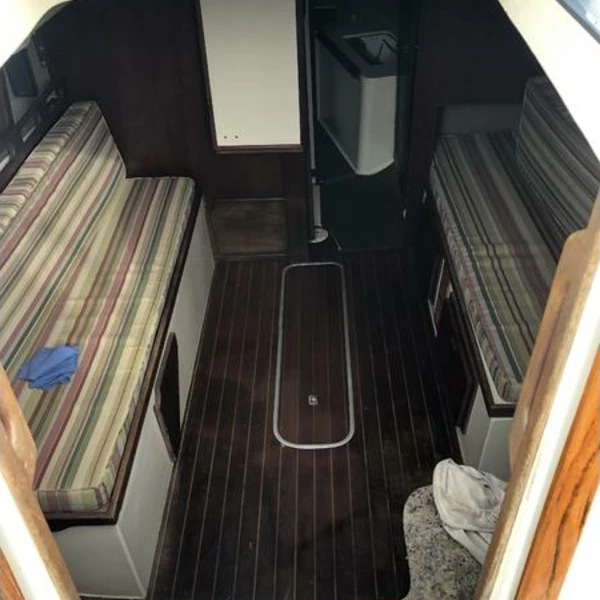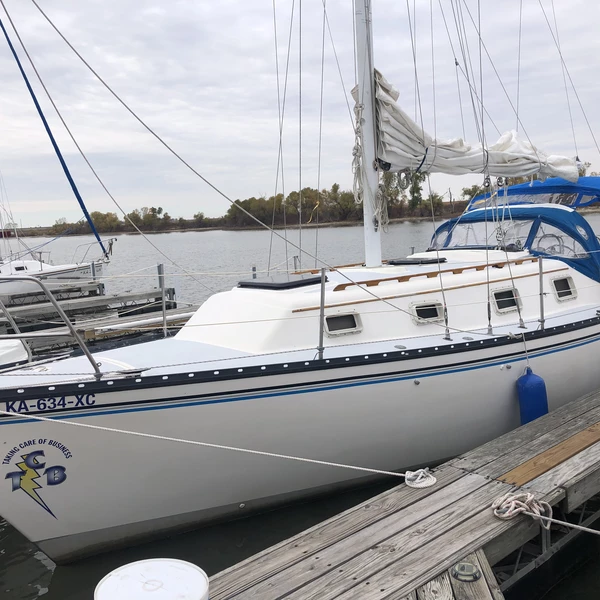Seller's Description
This is a great starter boat for a sailor, fast, forgiving and easy to sail. There are four berths and a large cockpit making it a great mini cruiser for couples or families, great for overnight weekends. The dodger and bimini makes for dry sailing. The Yanmar 15hp makes an easy in and out of slips and anchorages. Boat underwater was recoated in 21. Sails are in good condition, genoa is on Harkin roller furler. AC and refrigeration work very well to keep things cold in the hot summer. Set-up and ready to go sailing. This boat comes with a triple axel trailer so can go anywhere!!! Also spare engine parts come with this boat. Did a refit in 21, give me a call and I’ll go over everything with you. Thanks Terry
Equipment: Main sail 120% Genoa on Harkin furler Lorance 16,000 btu AC Refrigerator Microwave HW heater New bottom 21 New batteries 21 Ports regasketed 21 3 Ports replaced 21 Chain plates insp, rebedded 21 Stereo and speakers 21 Bilge pump 21 Spreader led 21 led light conversion 21 Shaft seal repacked 21 Electric head Depth Knot Apparent wind indicator Cockpit cushions BBQ Boat hook Heavy Danforth 150’ nylon rode Sail cover Triple axel trailer
Specs
- Designer
- John Cherubini
- Builder
- Hunter Marine
- Associations
- ?
- # Built
- 1000
- Hull
- Monohull
- Keel
- Fin
- Rudder
- Skeg
- Construction
- FG (solid hull and balsa deck)
Dimensions
- Length Overall
- 29′ 11″ / 9.1 m
- Waterline Length
- 25′ 9″ / 7.9 m
- Beam
- 10′ 0″ / 3.1 m
- Draft
- 4′ 11″ / 1.5 m
- Displacement
- 9,700 lb / 4,400 kg
- Ballast
- 4,100 lb / 1,860 kg
Rig and Sails
- Type
- Sloop
- Reported Sail Area
- 453′² / 42.1 m²
- Total Sail Area
- 453′² / 42.1 m²
Mainsail
- Sail Area
- 197′² / 18.3 m²
- P
- 34′ 2″ / 10.4 m
- E
- 11′ 6″ / 3.5 m
- Air Draft
- ?
Foresail
- Sail Area
- 257′² / 23.8 m²
- I
- 39′ 11″ / 12.2 m
- J
- 12′ 9″ / 3.9 m
- Forestay Length
- 41′ 11″ / 12.8 m
Auxilary Power
- Make
- Yanmar
- Model
- ?
- HP
- ?
- Fuel Type
- Diesel
- Fuel Capacity
- 12 gal / 45 l
- Engine Hours
- ?
Accomodations
- Water Capacity
- 33 gal / 125 l
- Holding Tank Capacity
- ?
- Headroom
- ?
- Cabins
- 1
Calculations
- Hull Speed
-
7.5 kn
Classic: 6.8 kn
Hull Speed
The theoretical maximum speed that a displacement hull can move efficiently through the water is determined by it's waterline length and displacement. It may be unable to reach this speed if the boat is underpowered or heavily loaded, though it may exceed this speed given enough power. Read more.
Formula
Classic hull speed formula:
Hull Speed = 1.34 x √LWL
A more accurate formula devised by Dave Gerr in The Propeller Handbook replaces the Speed/Length ratio constant of 1.34 with a calculation based on the Displacement/Length ratio.
Max Speed/Length ratio = 8.26 ÷ Displacement/Length ratio.311
Hull Speed = Max Speed/Length ratio x √LWL
- Sail Area/Displacement
-
15.9
<16: under powered
Sail Area / Displacement Ratio
A measure of the power of the sails relative to the weight of the boat. The higher the number, the higher the performance, but the harder the boat will be to handle. This ratio is a "non-dimensional" value that facilitates comparisons between boats of different types and sizes. Read more.
Formula
SA/D = SA ÷ (D ÷ 64)2/3
- SA: Sail area in square feet, derived by adding the mainsail area to 100% of the foretriangle area (the lateral area above the deck between the mast and the forestay).
- D: Displacement in pounds.
- Ballast/Displacement
-
42.3
>40: stiffer, more powerful
Ballast / Displacement Ratio
A measure of the stability of a boat's hull that suggests how well a monohull will stand up to its sails. The ballast displacement ratio indicates how much of the weight of a boat is placed for maximum stability against capsizing and is an indicator of stiffness and resistance to capsize.
Formula
Ballast / Displacement * 100
- Displacement/Length
-
253.5
200-300: moderate
Displacement / Length Ratio
A measure of the weight of the boat relative to it's length at the waterline. The higher a boat’s D/L ratio, the more easily it will carry a load and the more comfortable its motion will be. The lower a boat's ratio is, the less power it takes to drive the boat to its nominal hull speed or beyond. Read more.
Formula
D/L = (D ÷ 2240) ÷ (0.01 x LWL)³
- D: Displacement of the boat in pounds.
- LWL: Waterline length in feet
- Comfort Ratio
-
25.0
20-30: coastal cruiser
Comfort Ratio
This ratio assess how quickly and abruptly a boat’s hull reacts to waves in a significant seaway, these being the elements of a boat’s motion most likely to cause seasickness. Read more.
Formula
Comfort ratio = D ÷ (.65 x (.7 LWL + .3 LOA) x Beam1.33)
- D: Displacement of the boat in pounds
- LWL: Waterline length in feet
- LOA: Length overall in feet
- Beam: Width of boat at the widest point in feet
- Capsize Screening
-
1.9
<2.0: better suited for ocean passages
Capsize Screening Formula
This formula attempts to indicate whether a given boat might be too wide and light to readily right itself after being overturned in extreme conditions. Read more.
Formula
CSV = Beam ÷ ³√(D / 64)
- Beam: Width of boat at the widest point in feet
- D: Displacement of the boat in pounds
Notes
Shoal draft: 4.3’.
A keel/cb version was also available.
Tall Rig:
I: 42.00’/12.80m
J: 12.83’/3.91m
P: 37.00’/11.28m
E: 10.70’ / 3.26m
Total (100% main +fore.): 467.38 ft2/43.42 m2
an unfinished (kit) version was called the QUEST 30.
This listing is presented by SailboatListings.com. Visit their website for more information or to contact the seller.

















